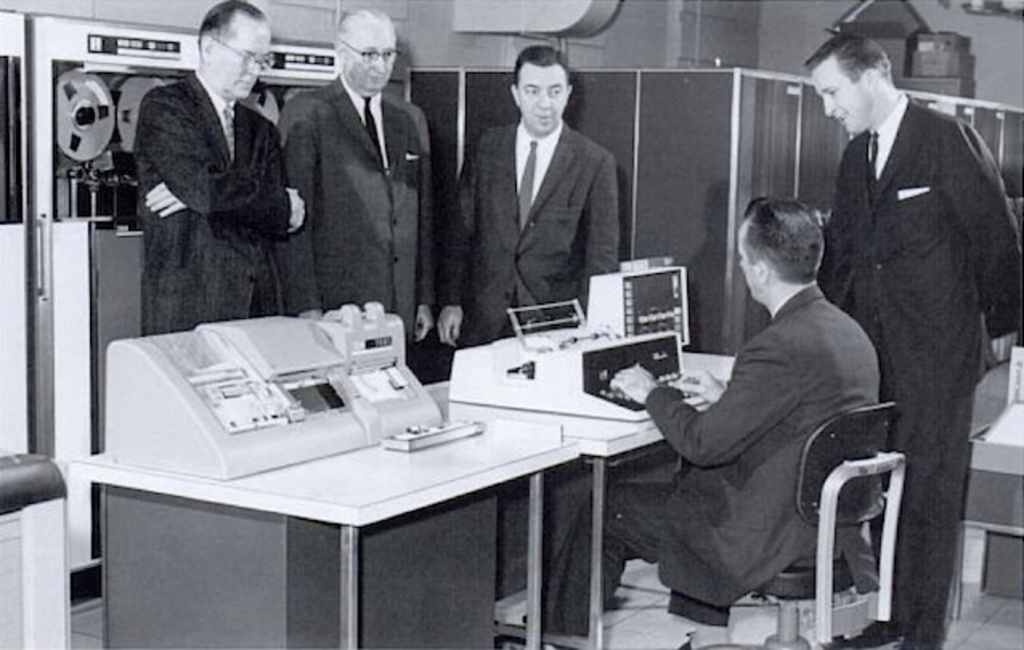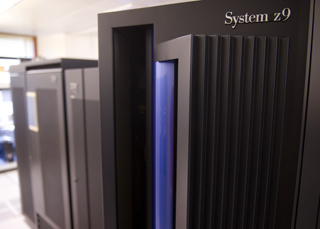When the University of Iowa’s mainframe computer system moved to new Jessup Hall quarters in 1988, it filled an entire room.
Now, it occupies a corner. Soon, it’ll disappear altogether.
On April 1, the university’s mainframe was powered down for the final time, more than 50 years after the first campus mainframes brought high-performance computing to the UI.
“It’s been a slow decommissioning, and the MAUI launch marked the last phase,” says Rich France, senior systems architect with Information Technology Services. “This is really the end.”
France retired in 2010, but has continued to work a few hours each week during the mainframe’s twilight years. He’s not the least bit sentimental about shutting down the machine.
“In computing, we’re always in transition,” he says. The changes of the past half-century have been truly remarkable, even for France and other UI pioneers who saw from the start the potential of computers.
Research tools
Mainframes powered decades of UI academic and administrative functions. The university’s first computing center opened in 1958 with an IBM 650, the world’s first mass-produced computer (which, foretelling tech’s future, soon became obsolete).
Two of the center’s first customers: James Van Allen and E.F. Lindquist.
Van Allen, professor of physics and astronomy, needed to crunch data from orbiting satellites. Lindquist, professor of education, was looking to score tests taken by thousands of schoolchildren.

Gerard Weeg, who became the computer center’s director in 1964, saw plentiful opportunities for expansion.
“Maybe even more than his predecessors, Weeg believed computing would be important to research and teaching in all disciplines,” says Bill Decker, former associate vice president for research and director of ITS.
Well into the 1970s, computing needed evangelists who could help potential users understand the implications of early programming languages, punch cards, and the terminals scattered around campus.
“I remember being sent out to visit a local engineering firm. They had a big box of computer cards, but no idea what to do with them,” says Rex Pruess, UI senior IT director who like France and Decker was among the university’s early group of programmers. “They treated me like a celebrity.”
All business
What’s a mainframe?
Sometimes called “big iron,” a mainframe is a large-scale computer that can support thousands of users simultaneously and run vital operations reliably and securely. The mainframe probably got its name from massive metal frames that once housed it, often occupying thousands of square feet.
University business processes were running off mainframes, too. Administrative Data Processing was the home for much of this work.
“We supported a lot of things over the years—the University Libraries catalog, payroll and financial transactions, student records, and so on,” France says. UI Hospitals and Clinics operated its own mainframe, so France and colleagues also built bridges to share data across campus systems.
By 1989, shifts in technology and demand let system administrators combine academic and business functions into a single mainframe, the one located in Jessup. And there were portents of even greater change.
“In the late 1970s, small personal machines—many of them hobby computers—had started to appear,” Decker recalls. “Those of us in the business saw a major impact coming, although no one could have predicted its extent.”
As personal computers landed on desktops across campus, functions continued to shift away from the mainframe. Personnel data, library records, and more moved on to new platforms.
A couple of years ago, the academic side of the mainframe was shut down. Eventually, only student records remained on the administrative side. With the launch of MAUI in 2012, the time to retire the mainframe had come.
Faster, smaller, cheaper
Technologists have been predicting the mainframe’s extinction for more than 20 years. Nevertheless, big businesses, government agencies, and others continue to run mainframe systems.

At the UI, new options provide the computing power required by today’s researchers. A high-performance computing cluster dubbed Helium debuted in early 2011, and another cluster—Neon—is in the works. The clusters connect hundreds of individual computers to solve problems that previously would have been fed to supercomputers at other institutions.
On the administrative side, systems like MAUI (which stands for Made At the University of Iowa) add new functionality, provide remote access, and offer more intuitive user interfaces.
Once computers resided in vast boxes that filled rooms. Now they’re literally everywhere.
“We carry around more computing power in our laptops than what the early mainframes could offer,” France says. “The memory those first machines had wouldn’t be adequate for today’s average cell phone.”
Maybe even more profound, says Decker, are the changed relationships between people and computers.
“At one time, users would submit a deck of computer cards, wait for us to run them through a batch system, then come back to collect printouts with their data. They had no interaction with the computer,” he explains.
“As people got their own computers, the paradigm completely changed. Today, computing is highly interactive and personal. Every user has complete control.”